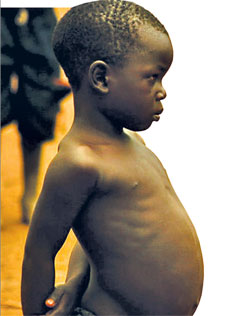Drumsticks to beat malnutrition!
Malnutrition, especially among children is a growing global
challenge. Even in Sri Lanka it has been a persistent health challenge
with a large number of children suffering from it due to various
reasons. The global statistics are startling and the problem needs to be
addressed immediately before another innocent child becomes a victim.
More than 1 in 5 under-five- year-olds are underweight in the world.
Nearly 1 in 6 babies born has a low birth weight. Low birth weight is a
major cause of malnutrition in children under five years old. However
,there are many areas that needs to be looked into to overcome the
challenging situation which can turn into a crisis. And the intake of
food and its nutritional levels is certainly a significant component.
 It is in this context that today we like to introduce the wonder tree
. Moringa oleifera or the drumstick tree that has been identified as a
good malnutrition combatant and advocated as the “natural nutrition for
the tropics, by experts .As it is a plant that grows abundantly in our
country,especially in the rural areas, where malnutrition is high it may
prove profitable to conduct studies about the nutritional aspects of the
tree and promote its nutritional value among the local population,
especially in areas where incidence of malnutrition are high. It is in this context that today we like to introduce the wonder tree
. Moringa oleifera or the drumstick tree that has been identified as a
good malnutrition combatant and advocated as the “natural nutrition for
the tropics, by experts .As it is a plant that grows abundantly in our
country,especially in the rural areas, where malnutrition is high it may
prove profitable to conduct studies about the nutritional aspects of the
tree and promote its nutritional value among the local population,
especially in areas where incidence of malnutrition are high.
Since the Moringa tree (murunga trees as it is popularly called in
Sri Lanka)is in full leaf even at the end of the dry season when other
foods are typically scarce in the tropics, it is indeed an ideal source
of food to combat nutrition.
Having often eaten the seed pods which are called ‘ drumsticks’ by
some, you may be surprised to learn that the yield, especially the
leaves from the nutritious tree have been used widely to fight
malnutrition.
According to published data, Moringa trees have been used to combat
malnutrition, especially among infants and nursing mothers. The
nutritional qualities are said to be very high and according to both
scientific and popular literature the leaves of the tree are believed to
contain more vitamin A than carrots, more calcium than milk, more iron
than spinach, more vitamin C than oranges, and more potassium than
bananas. Even the protein quality of the leaves are said to rival that
of milk and eggs but this is yet to be tested.
The moringa tree is popular for both food and medicinal uses. The
immature green pods called “drumstick” are generally the most valued and
widely used part of the tree and are prepared in a wide range of dishes.
Many a local housewife may have used moringa leaves especially when
cooking shell fish such as prawns and crabs. But some may be unaware
that the leaves can be eaten in so many other ways too; they can be
eaten cooked or even stored as dried powder for many months without
refrigeration, and reportedly without loss of nutritional value.
So, let’s check out some interesting facts about this Moringa tree
which is an exceptionally nutritious vegetable tree with a variety of
potential uses. Most of you are familiar with the fact that the coconut
tree is a very useful tree as every part of it can be used by us for
food or has some other beneficial property. You can add the moringa or
drumstick tree too to your list of useful trees. It is considered one of
the world’s most useful trees, as almost every part of the tree can be
used .
In the tropics, it is used as forage for livestock, and in many
countries, moringa micronutrient liquid, is a natural anthelmintic
(kills parasites) and is an adjuvant (to aid or enhance another drug) .
It is used as a metabolic conditioner to aid against endemic diseases in
developing countries. A traditional food plant in Africa, this
little-known vegetable has potential to improve nutrition, boost food
security, foster rural development, and support sustainable land care.

The widely cultivated species is also known as the drumstick tree,due
to the appearance of the long, slender, triangular seed pods.
The tree is rather slender,and has branches that droop. It grow to
approximately 10 m in height. It is particularly suitable for dry
regions.
The drumstick can be grown using rainwater without expensive
irrigation techniques. The yield is good even if the water supply is
not. The tree can be grown even on land covered with 10–90 cm of mud.
It is grown mainly in semi-arid, tropical, and subtropical areas.
Today it is widely cultivated in Africa, India, Indonesia, Malaysia,
Mexico, Philippines, Central and South America, and in Sri Lanka. India
is the largest producer of Moringa, with an annual production of 1.1 to
million tonnes of tender fruits from an area of 380 km². Moringa is
grown in home gardens and as living fences in Thailand, where it is
commonly sold in local markets.
The many uses of moringa:
* The immature green pods- “drumstick” are generally prepared in a
wide range of dishes.
* The seeds are sometimes removed from more mature pods and eaten
like peas or roasted like nuts.
* The flowers are edible when cooked and are said to taste like
mushrooms.
* The roots are shredded and used as a condiment in the same way as
horseradish.
* The leaves are cooked and used like spinach.
* Its leaves are also dried and crushed into a powder, and used in
soups and sauces.
* It is said that Moringa leaves and pods are helpful in increasing
breast milk in the breastfeeding months. One tablespoon of leaf powder
provide 14 per cent of the protein, 40 per cent of the calcium, 23 per
cent of the iron and most of the vitamin A needs of a child aged one to
three.
Six tablespoons of leaf powder will provide nearly all of a woman’s
daily iron and calcium needs during pregnancy and breastfeeding.
* The Moringa seeds yield 38–40 per cent edible oil (called bean oil
from the high concentration of behenic acid contained in the oil).
* The refined oil is clear and odurless and resists rancidity at
least as well as any other botanical oil.
* The seed cake remaining after oil extraction may be used as a
fertilizer or as a flocculent to purify water.
* The bark, sap, roots, leaves, seeds, oil, and flowers are used in
traditional medicine in several countries.
* In Jamaica, the sap is used for a blue dye.
* The flowers are also cooked and relished as a delicacy in West
Bengal and Bangladesh, especially during early spring.
* In India, where its triangular, ribbed pods with winged seeds are
used as a vegetable crop.
* The seeds are also considered an excellent bio fuel source for
making bio diesel.
* The fruit meat of drumsticks, including young seeds, is used for
soup.. Young leaves can either be fried with shrimp or added as a
topping in fish soup.
*The tree’s bark, roots, fruit, flowers, leaves, seeds, and gum are
also used medicinally. Uses include as an antiseptic and in treating
rheumatism, venomous bites, and other conditions.
* Moringa is also actively cultivated by the AVRDC in Taiwan. The
AVRDC is “the principal international centre for vegetable research and
development in the world. Its mission is to reduce poverty and
malnutrition in developing countries through improved production and
consumption of vegetables.”
* Extract from the seeds is used as a flocculant in a low-cost form
of water treatment.
* In the Maldives the leaves are often fried and mixed with
dried-fried tuna chips (Maldive fish), onions and dried chillies. This
is equivalent to a sambal and eaten along with rice and curry or
Garudhiya. The pods are called “Muranga Tholhi” and it is used to cook a
mild curry called “Kiru Garudhiya”.
[Fact file]
*The leaves and stem of M. oleifera are known to have large amounts
of their calcium bound in calcium oxalate crystals,which is not a form
of calcium available to the body. Whether the claim of “more calcium
than milk” includes this non-bio available calcium needs to be
addressed.

* The oral histories recorded by Lowell Fuglie in Senegal and
throughout West Africa report countless instances of lifesaving
nutritional rescue that are attributed to Moringa.
*The nutritional properties of Moringa are now so well-known that
there seems to be little doubt of the substantial health benefit to be
realized by consumption of Moringa leaf powder in situations where
starvation is imminent. However , presently not much clinical studies
have been conducted in this area the data of such studies would
certainly be of great value.
* This tree is not to be confused with the Golden Shower Tree (Cassia
fistulosa) which is also sometimes called by this name .
* It is the only genus in the family Moringaceae.
* Bureau of Plant Industry, in its report, stated that weight per
weight, Moringa leaves have the calcium equivalent of 4 glasses of milk,
the vitamin C content of 7 oranges, potassium of 3 bananas, 3 times the
iron of spinach, 4 times the amount of vitamin A in carrot, and 2 times
the protein in milk.
What is malnutrition ?
Have you seen malnourished children? If you have, then you will know
that they are very skinny with potruding bones and often have bulging
stomaches too. They are not healthy at all. If you are not aware as to
what exactly malnutrition means, here is the answer. It is a condition
that develops as a result of the body not getting the right amount of
nutrition;vitamins, minerals and other nutrients needed not only to
maintain healthy tissue but also to ensure the functioning of all organs
in the body. Malnutrition usually occurs in people who are either
undernourished or overnourished.
Undernutrition is a consequence of consuming too few essential
nutrients or using or excreting them more rapidly than they can be
replaced.
Protein-energy malnutrition has been identified as the leading cause
of death in children in developing countries . This type of malnutrition
is the result of inadequate intake of calories from proteins, vitamins,
and minerals. Children who are already undernourished can suffer from
protein-energy malnutrition (PEM) when rapid growth, infection, or
disease increases the need for protein and essential minerals.
These essential minerals are known as micronutrients or trace
elements. About one per cent of children in the United States suffer
from chronic malnutrition, in comparison to 50 per cent of children in
southeast Asia. About two-thirds of all the malnourished children in the
world are in Asia, with another one-fourth in Africa.Malnourished
children may be short for their age, thin, listless, and have weakened
immune systems.
Facts and pix : Internet |

